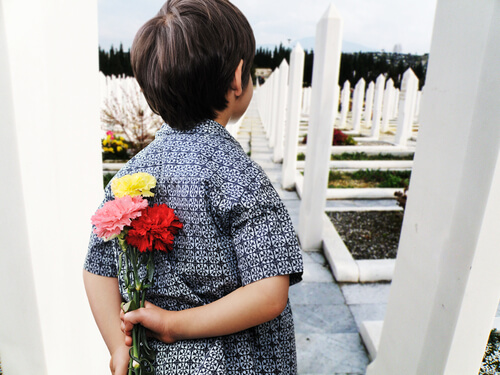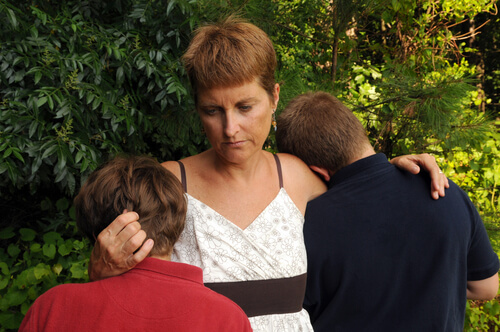How to Help Children Understand and Face the Concept of Death

If a child has to face the concept of death first hand, then one of the most important tasks of the child’s development will be to endure that pain.
Adults need to help the child see the objective reality of death and reshape the experience to make it simpler. Otherwise, the child will develop myths about immortality, and his or her inner reality will be altered.
Advice for talking to your child about the death of a loved on
During hard times like these, it’s important to know a few guidelines about how to communicate the news to children:
- Above all else, promote the child’s sense of security. This is even more important if one of the pillars of the family has passed away. In this case – especially if the deceased is one of the child’s parents – the child won’t only feel deep sadness. The child may also begin to wonder what would happen if he or she lost another parent or close loved one.
- Never, ever lie to your child. A very common way that parents have for explaining the absence of a loved one is to use the metaphor of travelling. However, saying the loved one is away on a trip only creates the false expectation that the person will one day come back. You should also be very careful about relating death to illness. If you do, the child may begin to fear death any time he or someone else gets sick.
- Let the child express his or her feelings. During infancy, children express their pain through anger and tantrums. If your child expresses emotions this way, you need to stay calm. Talk with your child and help him or her process this difficult moment.
- Answer your child’s questions. Don’t change the subject if the child asks a question that makes you uncomfortable. This will generate the idea that certain subjects are taboo. Furthermore, the child will end up believing that you don’t care about his or her doubts.
- Don’t respond with lies or try to sugar coat reality to protect the child. You simply need to be careful about what words you choose as your dialogue with your child. The goal is for the child to understand death and see it as something natural. Let the child see reality, but leave out any drama that can be damaging. And don’t make the mistake of believing that children aren’t prepared to face certain situations.

Childhood mourning: One step ahead of death
The way a child mourns depends on a variety of factors. For example, the child’s age as well as his or her closeness and relationship to the deceased individual. The cause of death is also a factor and, in cases of illness, how long the person was sick.
When children have reached a certain age and maturity level, it’s a good idea for parents to take them to the hospital so they can say their goodbyes. Of course, the parents need to know how to prepare the child for what he or she will encounter. They also need to be prepared for the way their child may react.
“The first phase of mourning, according to Worden, is accepting the loss as a reality”
In the case of a loved one’s death, it’s important to talk to children about it as soon as possible. Even if this is difficult and painful, it’s best to communicate the news to children within a few hours. Find the right time and place to explain to your child what’s happened. Tell the truth in a simple and sincere way.
At the same time, consider allowing the child to attend and participate in the funeral. This can help the child understand and accept the person’s death and face the mourning process the best way possible.
If the parents are too overwhelmed by the situation, then another family member or close family friend should tend to the child during the funeral.
Once again, we want to emphasize the importance of being there for the child, both physically and emotionally. Help the child express himself, share his feelings, and remember good times shared with the deceased.

Scientific studies about children and the concept of death
Studies about children and the concept of death are especially vague. Furthermore, most research is found in very old publications.
From the perspective of developmental psychology, Jean Piaget highlights the fact that children lack an ample vocabulary and capacity for abstract thinking. This creates an obstacle when it comes to adults being able to understand what a child is experiencing.
“The comprehension of death changes with age”
–Piaget–
From the perspective of Sigmund Freud, children don’t understand the true implications of death. This author wrote that death has no importance whatsoever in the psychological development of children.
John Bowlby, pioneer of the Attachment Theory, also addresses the issue of death. He claims that children under the age of 10 don’t fear death. Rather, this fear appears later on, as time goes by. The beginning of this feeling is related to the concept of separation, according to this theorist.
Lastly, different studies and researchers all seem to agree on one thing in general. They agree that there exists a certain omission of death. For Irvin D. Yalom, the reason is that there is a process of repression that derives from humanity’s universal tendency to deny death.
Death is only a stage in our lives, and there’s no reason to fear it. We need to naturalize death from an early age in order to instill the concept in children for what it is. Death is the final, inevitable stage of life.
All cited sources were thoroughly reviewed by our team to ensure their quality, reliability, currency, and validity. The bibliography of this article was considered reliable and of academic or scientific accuracy.
- García, M. F. C. (2013). La educación para la muerte. Un reto formativo para la sociedad actual. Psicogente, 16(30), 424-438. https://www.redalyc.org/pdf/4975/497552364014.pdf
- Gónzalez, I. & Herrán, A. (2010). Introducción meto- dológica a la muerte y los miedos en educación infantil. Tendencias Pedagógicas, 15, 124-149.
- Herrán, A. & Cortina, M. (2008b). La muerte y su di- dáctica. Manual para educación infantil, primaria y secundaria. Madrid: Universitas.
- Neimeyer, R. A., & Ramírez, Y. G. (2007). Aprender de la pérdida: una guía para afrontar el duelo. Paidós.
This text is provided for informational purposes only and does not replace consultation with a professional. If in doubt, consult your specialist.
